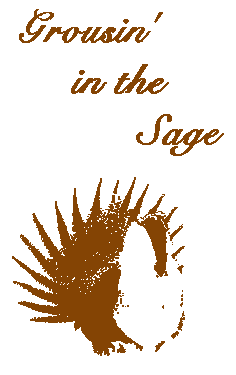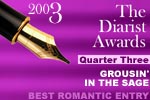






powered by SignMyGuestbook.com

| Newest
Older Previous Next Random Contact Profile Host |
blizzard warnings - 13:52 , 03 October 2013 heelerless - 21:32 , 18 August 2013 Red Coat Inn in Fort McLeod - 11:38 , 23 June 2013 rushing into the waters - 09:53 , 21 June 2013 choosing a spot - 17:43 , 27 April 2013 |
area 108 classed
(Entry number five for the day...not sure if they were all worth recording, but hey, it's the 13th.)
Finished area 108 this am: 341 does, 127 fawns, 115 adult bucks and 38 yearling bucks. Total of 621 antelope classified off of four routes.
So what does that all mean, Mr. Wizard?
Well, first, 621 antelope is the smallest sample I've collected off those routes in the eight years I've been running them. By far. High sample was 1,190 in 1996.
That suggests the country south of the Interstate may have been hit harder by the winter than the herds to the north. Warden reports unusually low numbers in the area immediately to the west as well.
To compare classifications, the data are expressed as ratios of the numbers per 100 does. So this year area 108 has roughly 37 fawns:100 does. That's crappy, but it's been worse. Figure that in a good year most adult does will have twins, with the yearling does usually only having singles. So at birth in June, you normally have between 150-180 fawns:100 does. Even in the best of years, natural mortality will take out about half of those by August.
But this year is not normal. Suspected a lot of does resorbed their fetuses last winter, and it appears that happened.
The dry summer would also reduce fawn survival. So 37:100 is not good, but a little better than I expected.
This sample suggests antelope numbers in this area only grew by 26 percent this summer. Good years might see more than a 50 percent increase. When things are going really good, you can double your antelope herd in just two to three years. Things haven't been going that well here for at least ten years.
The yearling buck:doe ratio was only 11:100. That also is low, but has also been worse. Suggests that we lost more of the 2000 fawn crop last winter than would be normal, and that also is no surprise. Ratio is almost identical to what we had in 1993, after the last tough winter this country has seen.
Total buck:doe ratio is only 44:100. Not good, but again it's been lower. Part of the drop is just because of the missing yearlings. While the fawn:doe ratio is the most important when you're trying to monitor and manage a herd, this buck:doe ratio is the one that hunters care about the most. Generally, the higher the ratio, the greater the proportion of older, more desireable bucks that are available for harvest. This 44:100 is respectable for much of our state, but not here where we have large blocks of public land and a tradition of providing better quality hunting.
Would be happier if that ratio were in the low to mid-50s.
The thing you have to watch out for with these statistics is to not read too much into them. These are samples, not counts.
And antelope shift their distribution all the time, mainly in response to weather, thunderstorms and where the best feed is. Area 108 does not contain an isolated herd of antelope. This herd covers all the country between the North Platte, the Continental Divide and the Interstate, which includes two other hunt areas. When the wardens finish their classifications in those areas we'll (read I) add them all together to see what is really happening this year.
And once the truck is fixed, it is off to classify area 61.